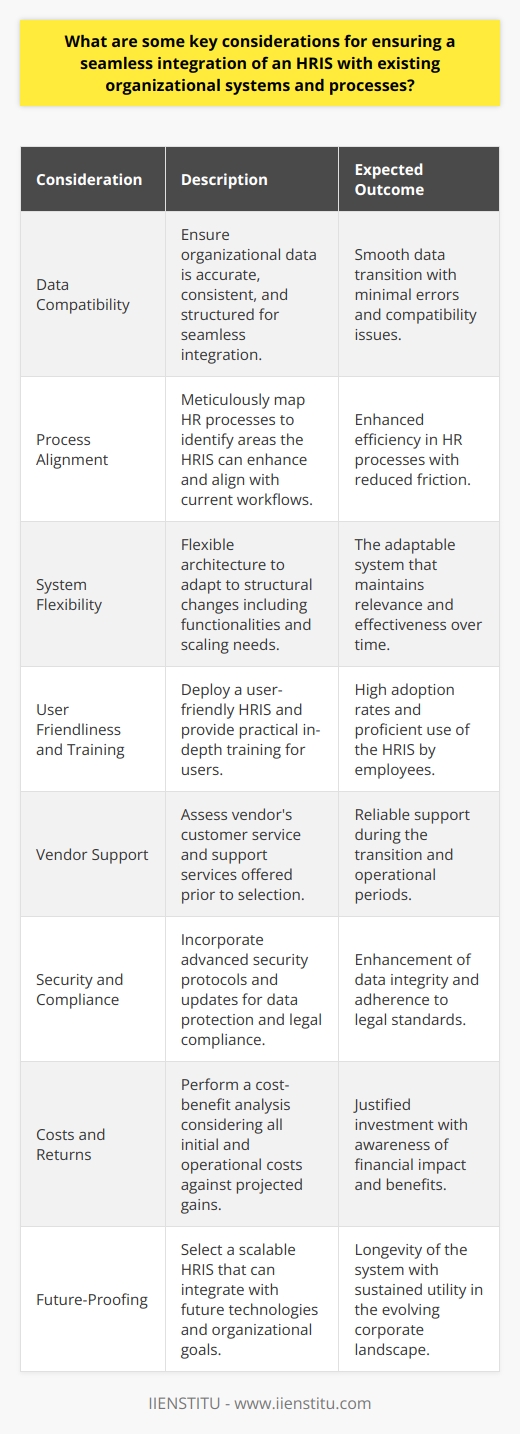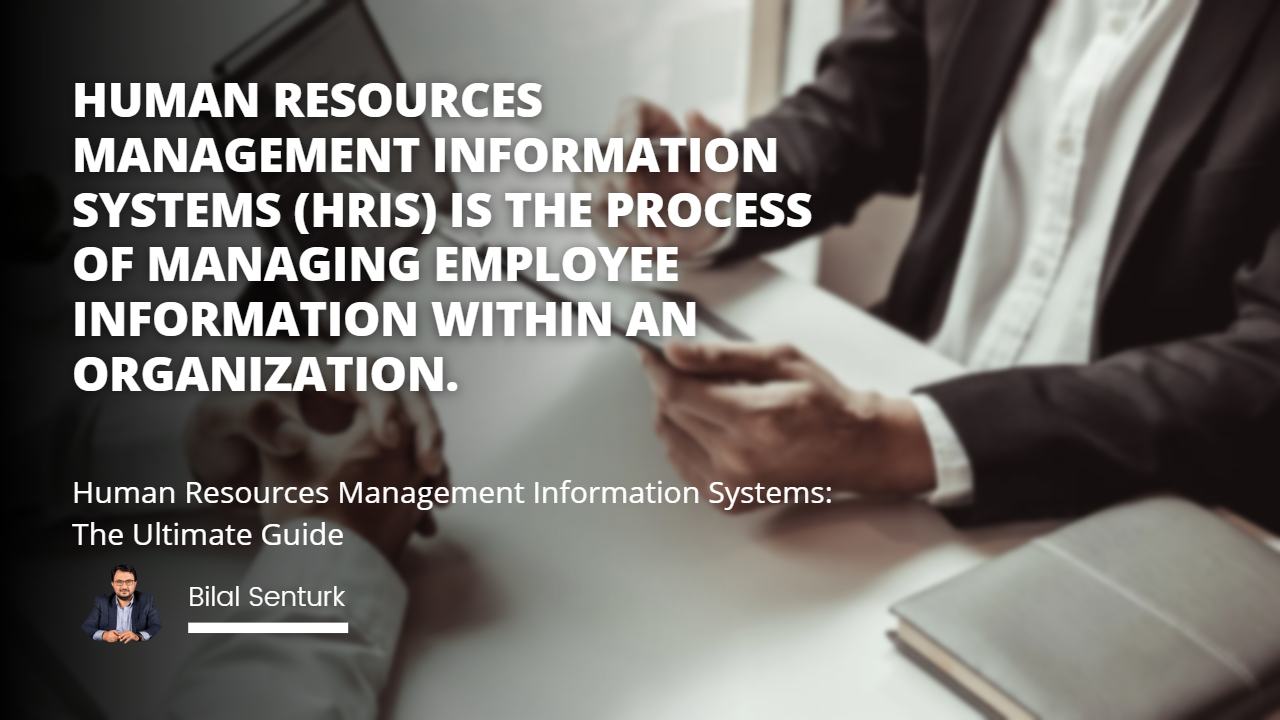
Are you looking for a comprehensive Human Resource Management Information Systems (HRIS) guide? You’ve come to the right place.
In this post, we’ll cover everything you need to know about HRIS, from its history and benefits, to how to select and implement the right system for your organization. Let’s get started!
Defining HRIS: What is it, and what does it do?
Human Resource Information Systems (HRIS) is a term used to refer to the systems and processes used to manage human resources within an organization. These can be hardware- or software-based systems and typically feature modules for employee recruitment, payroll, time tracking, attendance monitoring, job scheduling, benefits management, succession planning, and more.
HRIS solutions allow human resources professionals unprecedented access to human resource data necessary for Human Capital Management and analytics. By streamlining human resource practices and activities with HRIS, it becomes easier for organizations to focus on their core business competencies by reducing administrative overhead.
Furthermore, HRIS can facilitate cost savings over time by helping organizations better use human resource data to monitor and track trends and the effectiveness of personnel policies.
Related course: Fundamentals of Management
As a result, HRIS is often considered a cornerstone of human resources technology in modern organizations worldwide.
HRIS functions
HRIS systems have revolutionized Human Resources Management by providing a central hub for all HR-related activities. From tracking employee absences and salaries to running payroll, HRIS is an essential backbone of any human resource department.
Related course: Human Resources Management Course
Additionally, businesses can glean valuable insights from this information system to make informed decisions about their workforce. An HRIS makes it easier for human resource departments to organize, store, and manage all the necessary personnel and Human Resources Management data while allowing easy access to anyone who needs it.
No wonder businesses are turning to this information technology solution to increase effectiveness and efficiency when dealing with human resources.
1. Employee tracking
An HRIS can track employee data such as contact information, job titles, salary history, and performance reviews. This information can be used to manage employee records and to make informed decisions about hiring, promotions, and raises.
2. Time and attendance
An HRIS can also be used to track employee time and attendance. This information can be used to ensure that employees are working their scheduled hours and identify absenteeism patterns. Additionally, this information can be used to calculate payroll costs and monitor compliance with labor laws.
3. Benefits Administration
An HRIS can also administer employee benefits such as health insurance, retirement plans, and paid time off. This information can be used to manage benefit costs and ensure that employees receive the benefits they are entitled to.
4. Training and development
An HRIS can also be used to track employee training and development. This information can be used to identify training needs and to design development programs that meet those needs. Additionally, this information can be used to monitor employee progress and assess the effectiveness of training programs.
5. Reporting and analytics
An HRIS can also be used to generate reports and analytics that can be used to inform decision-making. For example, an HRIS can create an account on employee turnover or information on the cost of benefits per employee. Additionally, an HRIS can provide data that can be used to develop models for predicting future trends in areas such as workforce planning or compensation budgeting.
The benefits of using an HRIS
An HRIS can significantly reduce costs and streamline operations for human resources departments. An HRIS, or human resource management information system, is a powerful tool that allows users to manage human resources data easily.
With an HRIS, users can save time by automating routine human resource tasks such as recruiting, training, and performance management. Furthermore, an HRIS allows for accurate real-time reporting of human resource data such as employee attendance, time tracking, benefits, and payroll management.
Finally, an effective HRIS offers a central repository for critical human resources documents and policies that employees can quickly access from anywhere. Adopting an HRIS has numerous advantages that human resources professionals can capitalize on to maintain efficient and effective management of human resources activities.
The importance of HRIS
An organization's human resources management information system (HRIS) is vital for streamlining processes, managing human capital efficiently, and making informed decisions. This system makes it simple to track employee information such as time off requests and training records while removing tedious manual tasks like data entry, paper filing, and searching through documents to find the correct information.
It also helps managers keep a clear view of their team's progress and performance by consolidating the necessary data in one place. As a result, HRIS saves managers time while providing them with up-to-date data they can use to make critical decisions quickly - making it an essential element of any successful business.
How to select the right HRIS for your business
Selecting the right human resource management information system (HRIS) for your business is no small task. Some factors need to be considered, including cost, compatibility with existing systems, and the availability of analytics. When selecting an HRIS, evaluating your business needs and determining the most critical features is essential.
For example, does your business value employee engagement or tracking attendance? If so, look for HRIS solutions that offer automated online surveys and tools for tracking staff time and productivity. It’s also important to consider how the software will integrate with other data collection processes in your organization.
Related course: Time Management Course
For example, will the HRIS seamlessly connect with existing payroll software and other human resources programs? Considering all these factors, you can identify an HRIS that best fits your company’s unique needs, helping ensure efficient human resource management.
With careful consideration, you can select an HRMS system that helps streamline human resource processes without burdening your budget or workflow. Once implemented correctly, you’ll have fewer manual processes and more streamlined communication between human resources departments at every level—setting up an excellent foundation for organizational success.
Smooth human resource management is essential for any business—and finding the right HRIS solution is vital in achieving this goal. With a few considerations in mind during the selection process, you can find the right match for your organization’s human capital management needs.
Implementing an effective HRIS strategy
When it comes to human resource management, an effective human resource information system (HRIS) strategy is essential in any organization’s arsenal. HRIS systems enable increased transparency and accuracy when dealing with human resources data, ensuring a quicker, smoother process when tracking personnel data—effectively implementing such a strategy requires a comprehensive understanding of human resource management concepts and a systematic approach to setting it up.
Related course: Human Resources Development (HRD)
Organizations should first identify their specific human resource requirements, develop an inventory of necessary information, and then assign clear roles within the system. This should be followed by developing metrics and KPIs to measure effectiveness, alongside technical integrations to ensure compatibility between different software applications. With an appropriate implementation plan in place, organizations can ensure that each step of the human resource loading process is as efficient as possible. With this tailored solution, businesses can be confident that their HRIS strategy will increase operational efficiency and improve employee experiences.
Maintaining and updating your HRIS.
Keeping your human resource management information system (HRIS) up to date is essential for any modern business. An HRIS allows you to store, maintain and analyze employee-related data in one secure place, making it easier and faster to access crucial HR data when needed. However, simply purchasing an HRIS doesn’t guarantee that the system will remain fully optimized.
Regular maintenance and updates are necessary to keep your HRIS running at its best and ensure that it meets the latest needs of your business. This includes:
Regularly backing up data.
Updating and patching hardware.
Testing software compatibility issues.
Maintaining tight security protocols.
By taking care of these steps as part of an effective ongoing HRIS strategy, you can ensure that your system remains valuable over time. After all, a little maintenance can go a long way regarding human resources management systems.
An HRIS can be a valuable asset to any business. By understanding the benefits of using an HRIS and how to select the right system for your company, you can ensure that your HR department is running as efficiently as possible. Once you have implemented an effective HRIS strategy, you must maintain and update your system regularly to benefit from it.
For more information on human resources management and how to implement an effective HRIS strategy, we offer online courses that will provide you with all the information you need to make the most of your HR department.
Future of HRIS
The future of human resources management information systems (HRIS) looks very promising. HRIS technology has come a long way since its inception and is likely to continue advancing. Businesses of all sizes have started to recognize the value of investing in HRIS as it helps them automate manual processes, manage data accurately and obtain actionable insights that can give them a significant competitive edge.
Furthermore, with its ease of handling employee records from recruitment to retirement, businesses can make better-informed decisions regarding human capital-related matters. The introduction of enhanced AI solutions and machine learning capabilities is expected to make HRIS even more efficient for organizations worldwide soon.
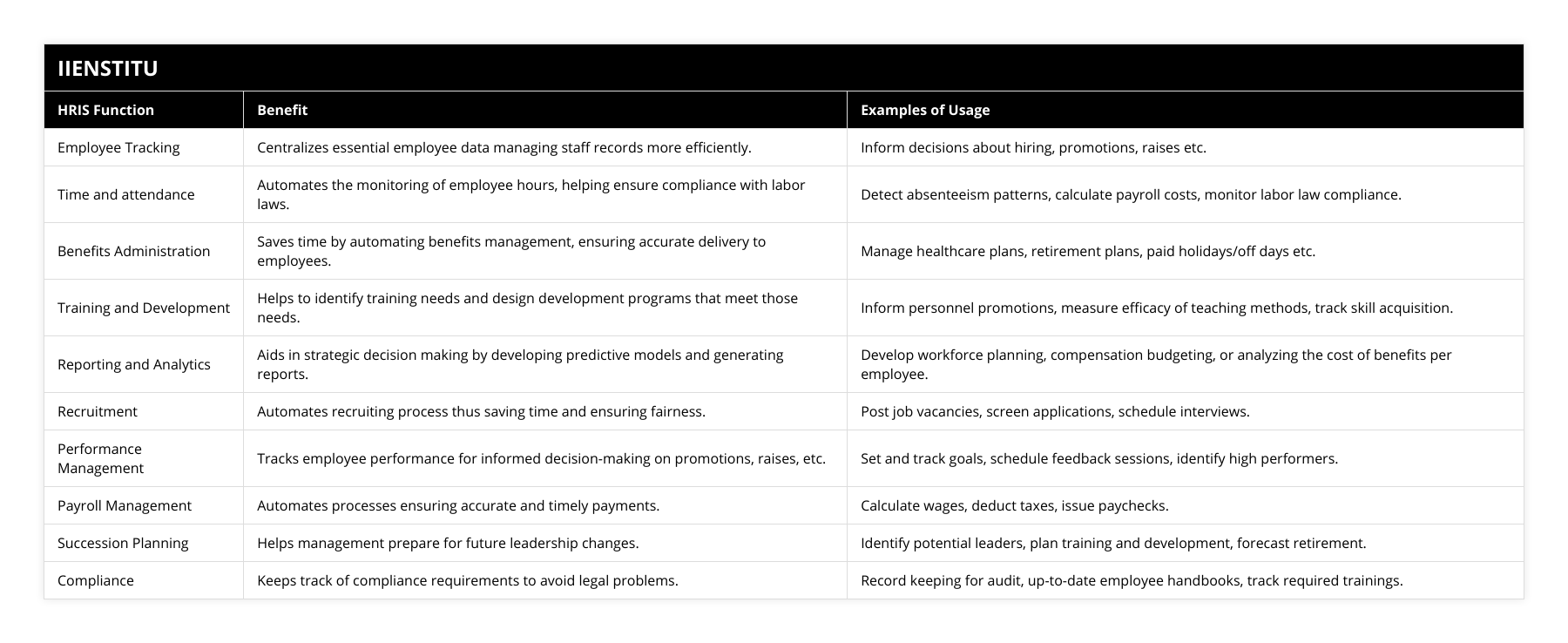
Frequently Asked Questions
What is an HRIS?
An HRIS (Human Resources Information System) is a software system used to manage and store employee data. It enables organizations to streamline their human resources processes, including recruitment, payroll, attendance tracking, performance analysis and more.
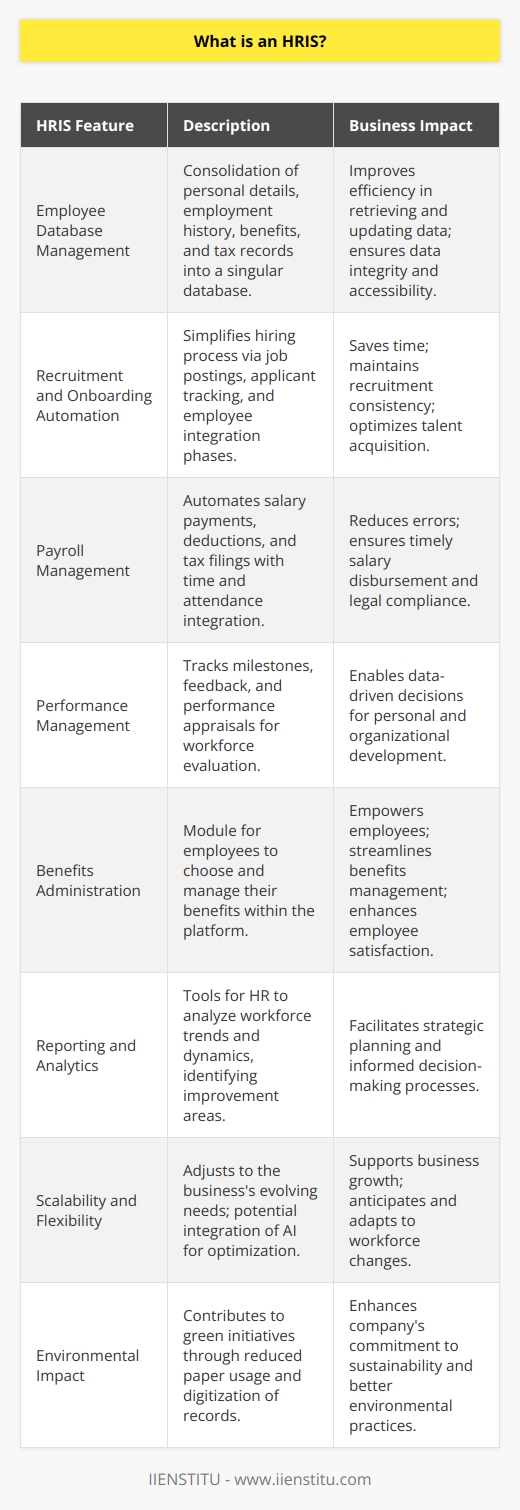
How do I maintain my HRIS?
Regular maintenance of your HRIS is essential for ensuring that your system remains optimized and efficient. This includes regularly backing up data, updating hardware and patching software compatibility issues, as well as maintaining tight security protocols.

What are the benefits of using an HRIS?
An HRIS can help businesses automate manual processes, improve accuracy when managing employee data, and obtain insights to help them make better-informed decisions regarding human capital-related matters. Additionally, the use of an HRIS can lead to improved operational efficiency and employee experiences.
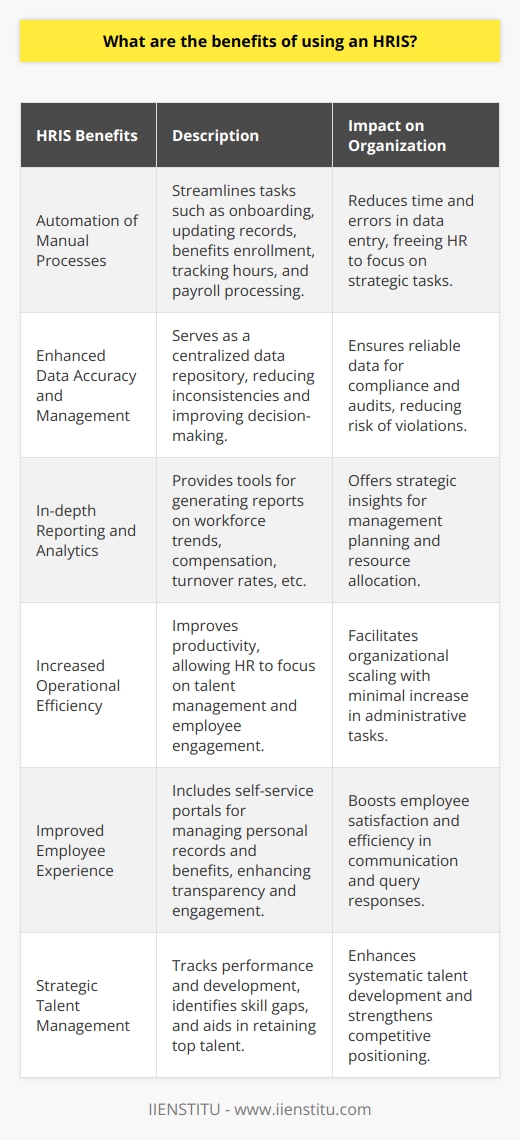
What types of data are typically stored in an HRIS?
Human resource information systems (HRIS) typically store a wide variety of data, including employee profiles, payroll information, benefit information, attendance records, performance reviews, training records, and more.

What are the key components of a successful HRIS implementation?
Clear Objectives: Establishing clear and measurable objectives for the HRIS implementation is essential for successful results.
Project Planning: A thorough and comprehensive project plan should be developed to ensure the success of the HRIS implementation.
Stakeholder Engagement: It is essential to engage stakeholders throughout the HRIS implementation process to ensure successful adoption.
Communication Plan: A comprehensive communications plan should be developed to ensure that stakeholders are aware of the HRIS implementation and its progress.
System Testing: Extensive system testing should be conducted to ensure that the HRIS functions as intended and meets the established objectives.
Training & Support: Training and support should be provided to users to ensure a successful HRIS implementation.
Data Migration: Data migration should be conducted to ensure that data is transferred accurately and efficiently from the old to the new system.
Change Management: Change management should be implemented to ensure successful adoption of the HRIS system by users.

How can an HRIS help improve employee engagement and retention?
An HRIS can help improve employee engagement and retention by providing employees with a platform to access their information, such as performance reviews, training resources, and career development opportunities. The HRIS can also allow for automated communication and feedback, enabling employees to provide and receive feedback quickly and easily. Additionally, an HRIS can provide managers with data and analytics to better understand the engagement and retention levels of their employees, and make adjustments accordingly.
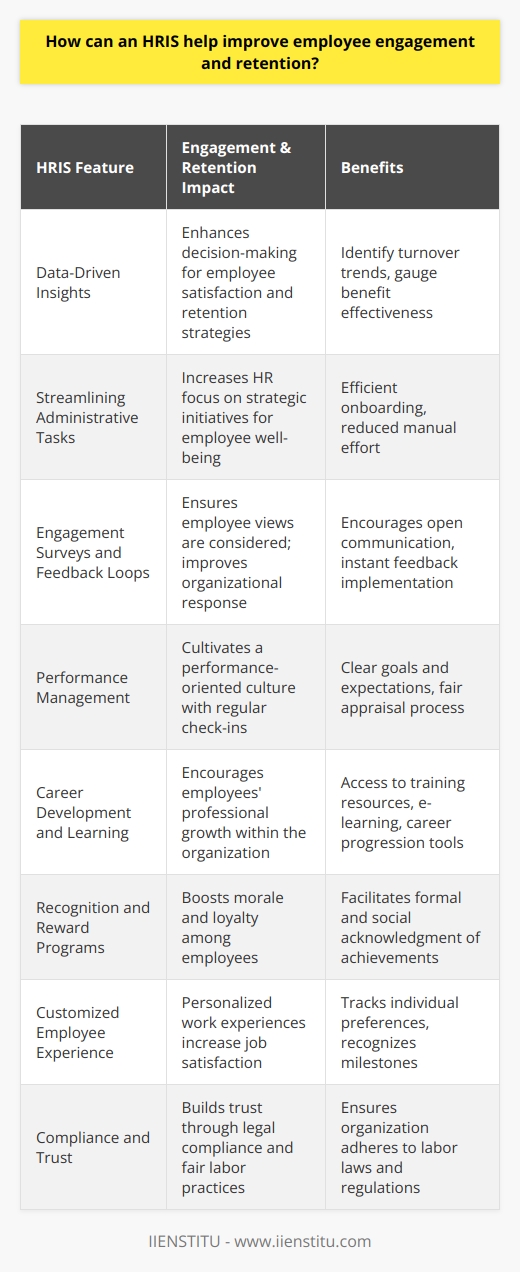
What are the different modules and features typically found in a human resource information system (HRIS)?
HRIS Modules and Features
A Human Resource Information System (HRIS) is an integrated software solution for managing an organization's human resources. Typically, an HRIS is made up of various modules and features designed to streamline HR functions and improve productivity.
Employee Administration
One of the primary modules in an HRIS is employee administration, which simplifies data collection, storage, and retrieval related to employees. This module includes information such as personal details, job history, performance evaluations, and training records.
Recruitment and Talent Acquisition
Another vital module is recruitment and talent acquisition, which plays a role in searching, screening, and selecting suitable candidates for job vacancies. Features include applicant tracking systems, resume databases, candidate searches, and interview scheduling.
Time and Attendance Management
The time and attendance management module simplifies the process of tracking employee work hours, attendance, and leave. This includes time tracking, shift scheduling, and leave management capabilities, ensuring compliance with labor laws and managing employee absences effectively.
Payroll Management
The payroll management module automates the calculation of employee wages and benefits, streamlining the process of payroll administration. This includes features like automated tax calculations, deductions, and compliance with regulatory requirements for accurate and efficient payroll processing.
Learning and Development
An HRIS also typically includes a learning and development module, which offers tools to manage employee training initiatives and skill development. This includes tracking employees' learning progress, course catalog management, and maintaining compliance with industry-specific training requirements.
Performance Management
The performance management module is essential for assessing and monitoring employee performance, ensuring alignment with company goals and objectives. Features include goal setting, performance reviews, feedback mechanisms, and performance appraisal management for a transparent and effective performance management process.
Benefits Administration
Lastly, the benefits administration module assists organizations in managing employee benefits like healthcare, pension, and insurance plans. This module automates the administration of benefit programs, including enrollment, claims processing, and compliance reporting, ensuring efficient management of employee benefits.
In conclusion, an HRIS offers various modules and features that are essential for streamlining human resource functions, improving productivity, and ensuring organizational success. By automating critical HR processes, HRIS systems contribute to an organization's ability to focus on strategic initiatives and drive employee engagement and satisfaction.

How does an HRIS enhance strategic decision-making for organizations?
Role of HRIS in Strategic Decision-Making
An HRIS, or Human Resource Information System, significantly enhances strategic decision-making for organizations by streamlining human resource processes. It provides accurate and up-to-date information, enabling HR professionals and business leaders to make data-driven decisions. With its aid, organizations can develop and execute effective HR plans that align with broader business strategies.
Improving Talent Management
One major area where HRIS contributes to strategic decision-making is talent management. By storing comprehensive employee data, HRIS allows organizations to track performance, identify top performers, and discover skill gaps. This information is crucial for informed decisions regarding recruitment, promotions, and employee development initiatives.
Data-Driven Workforce Planning
HRIS assists in workforce planning by offering insights into current and future staffing needs. Access to real-time workforce data ensures that organizations can make informed decisions about hiring, layoffs, and adjustments in employee roles. This information leads to cost-effective and efficient staffing strategies that further contribute to overall business success.
Enhancing Employee Engagement
Employee engagement directly impacts an organization's performance and productivity. HRIS helps in monitoring engagement levels and identifying engagement drivers, enabling organizations to design initiatives and policies to boost motivation and job satisfaction. Consequently, informed decisions in this area can strategically improve the workforce's performance and morale.
Risk Minimization and Compliance
Compliance with labor regulations and minimizing risks related to human resources are of paramount importance for organizations. HRIS enables easy access to relevant data for compliance reporting as well as tools for tracking regulatory changes. This supports strategic decision-making by ensuring that organizations remain legally compliant, avoiding penalties and preserving their reputation.
Effective Performance Management
Implementing efficient performance management strategies is essential for organizations to improve employee productivity and align individual goals with corporate objectives. HRIS assists in tracking employees' performance metrics and setting targets, which helps managers in strategic decision-making regarding employee evaluations, compensation adjustments, and training opportunities.
In conclusion, an HRIS plays a critical role in enhancing strategic decision-making for organizations by providing accurate, real-time data on various HR aspects. As a result, organizations can make informed decisions in talent management, workforce planning, employee engagement, risk minimization and compliance, and performance management. These strategic decisions ultimately contribute to overall business growth and success.

What factors should be considered while selecting an HRIS for a specific company?
System Compatibility
One major factor involved in selecting an HRIS for a specific company is the system's compatibility with existing software and hardware. The chosen HRIS should be able to seamlessly integrate with current systems and easily adapt to future technological changes. HRIS systems are often required to interface with multiple tools such as payroll, recruiting, performance management and other applications, making it essential to assess the compatibility of the software prior to implementation.
Organizational Needs and Goals
The HRIS should align with the company's needs and goals to optimize workforce management processes. Assessing the organization's size and workforce complexities, as well as its short-term and long-term objectives, can help identify an HRIS that will best support strategic plans. In addition, the HRIS should be capable of efficiently handling both routine tasks and more complex issues, such as compliance management and data security.
Customization and Scalability
A flexible HRIS that can be customized and scaled to accommodate changing needs is essential for a company's long-term success. Selecting an HRIS that offers a robust set of features and functionalities but that can also be tailored to the specific requirements of the organization will help ensure the system remains relevant and effective as the company grows and evolves. Additionally, it is crucial to examine the provider's track record for adapting to market trends and swiftly updating the system as needed.
User Experience and Training
Evaluating the user experience of the HRIS is important in determining the ease of use and efficiency of the system. A more user-friendly interface can help to reduce learning curves and improve adoption rates, while also streamlining processes for HR staff. Ensuring the system is intuitive and accessible for all users, including non-HR personnel, is critical. Additionally, evaluate the level of training and support offered by the HRIS provider to properly educate users on the system's features and functionalities.
Cost and Return on Investment
Lastly, companies must consider the total cost and potential return on investment when selecting an HRIS. This includes the initial purchasing price, ongoing maintenance fees, and any customization costs. It is essential to weigh the benefits and potential cost savings against the total expense and carefully analyze how the HRIS can help improve overall efficiencies, streamline processes, and enhance data-driven decision-making capabilities.
In conclusion, companies should carefully consider factors such as system compatibility, organizational needs, customization and scalability, user experience, and cost when selecting an HRIS. By thoroughly assessing these criteria, businesses can make an informed decision and invest in an HRIS that best suits their specific requirements and objectives.
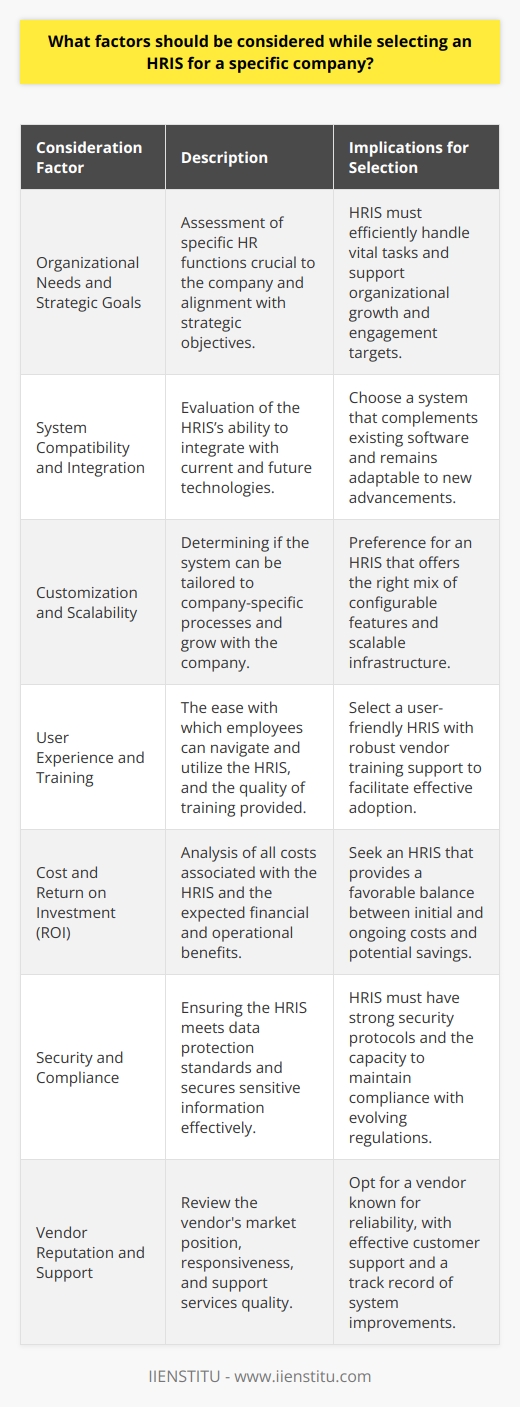
What functions and capabilities does a human resource information system (HRIS) typically offer?
Functions of a Human Resource Information System
Data Management and Organization
A Human Resource Information System (HRIS) functions as an effective data management tool, collecting, organizing, and storing employee-related information, such as personal details, job history, performance appraisals, and compensation data. This organized data enables efficient retrieval and effective decision-making processes.
Streamlined Recruitment and Onboarding
HRIS capabilities typically include applicant tracking and resume management features that enable human resource professionals to efficiently manage the recruitment process, pre-screen candidates, and streamline onboarding tasks for new hires, reducing time and effort required in the hiring process.
Time and Attendance Management
HRIS solutions offer time and attendance management features that assist organizations in accurately tracking employee work hours, leave balances, and attendance patterns. This information allows for streamlined payroll processing, monitoring of overtime, and adherence to labor laws and regulations.
Benefits Administration
Through a HRIS, businesses can effectively administer their employee benefits programs, including health insurance, retirement plans, and other perks. The system simplifies benefits management by automating enrollment, deductions, and changes in employee status, ensuring accurate record-keeping and compliance.
Performance Evaluation and Development
One important HRIS capability involves supporting performance management and employee development. The system can facilitate regular performance assessments, goal setting, and identification of training needs. This fosters employee growth and helps organizations retain high-performing personnel.
Labor Law Compliance
A comprehensive HRIS assists organizations in adhering to labor regulations and reporting requirements, such as equal employment opportunity, diversity, and wage and hour laws. The system stores crucial data, making it easy for HR professionals to retrieve and analyze the information needed to meet compliance standards.
Enhanced Reporting and Analytics
Utilizing the data stored in a HRIS, businesses can generate comprehensive reports and gain insights through analytics features. This enables effective decision-making related to workforce planning, talent acquisition, and employee engagement, ultimately leading to improved organizational performance.
In conclusion, a Human Resource Information System offers a wide range of functions and capabilities that streamline HR processes, enhance data management, and empower organizations to make informed decisions toward meeting their strategic goals.

How do privacy and security concerns impact the implementation of an HRIS?
Privacy Concerns in HRIS Implementation
One significant impact of privacy concerns in implementing a Human Resource Information System (HRIS) relates to data protection regulations such as the General Data Protection Regulation (GDPR). Organizations must ensure that their HRIS complies with these regulations, which aim to protect the privacy of personal data of employees. Failure to comply could lead to substantial fines and reputational damage.
Safeguarding Employee Data
In addition, privacy concerns necessitate strict policies and procedures for managing access to sensitive employee information. These policies must cover data storage, transfer, sharing, and disposal. Ensuring data privacy involves implementing strict access controls within the system, allowing only authorized personnel to access sensitive employee data.
Security Risks in HRIS
Security concerns also pose a challenge for HRIS implementation. Cyber threats could compromise the integrity of the system, leading to data breaches or potential system downtime. Organizations must adopt robust cybersecurity measures to protect their HRIS from unauthorized access, data theft, or other security incidents.
Securing HRIS Infrastructure
To mitigate security risks, organizations should invest in secure hosting solutions, such as cloud-based HRIS with strong security measures. These solutions could include encryption of data in transit and at rest, timely patching of security vulnerabilities, and constant monitoring for potential threats. Implementing multi-factor authentication for system access also adds an extra layer of security.
Employee Training for Secure Use
Another crucial aspect of addressing privacy and security concerns involves training employees for proper and secure use of the HRIS. Employees must understand the importance of protecting sensitive information, and their role in preventing data breaches. Periodic training on security best practices helps mitigate risks arising from human error or negligence.
In summary, privacy and security concerns critically impact the implementation of an HRIS. Organizations need to address these concerns through compliance with data protection regulations, implementation of strict policies for data privacy, adoption of robust cybersecurity measures, secure hosting solutions, and thorough employee training. By adequately addressing these concerns, organizations can implement an HRIS that offers a secure and efficient way of managing human resources.
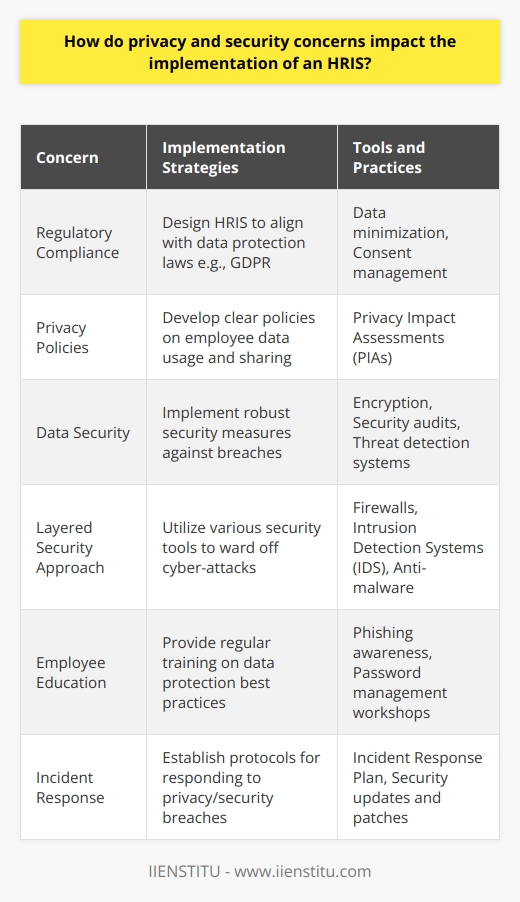
What role does HRIS play in the integration of human resources and overall business strategies?
Role of HRIS in Integration
Human Resource Information Systems (HRIS) play a crucial role in the integration of human resources and overall business strategies. HRIS enables companies to manage employees effectively and streamlines the human resource processes. By using technology, HRIS helps organizations align their human resource goals with business objectives, ensuring a smooth flow of information and decision-making.
Data Management and Analysis
Firstly, HRIS acts as a central repository for all employee data, including personal information, skills, qualifications, and performance records. This centralized database allows managers and HR professionals to track and analyze employee performance, identify skill gaps, and develop targeted training programs. Access to accurate and timely data helps organizations make better-informed decisions regarding employee development and retention, which are critical components of a successful business strategy.
Employee Performance and Goal Alignment
Secondly, HRIS plays a key role in performance management by providing a platform for setting and tracking individual and team performance targets in alignment with company goals. Through HRIS, managers can monitor employee progress, provide timely feedback, and identify high-performers and underperformers. This information ensures that employees are working towards the organization's strategic goals and fosters a culture of continuous improvement.
Recruitment and Talent Retention
Thirdly, HRIS contributes significantly to the integration of human resources and overall business strategies by automating the recruitment process. From posting job openings to applicant tracking, HRIS facilitates efficient candidate sourcing and selection, aligning talent acquisition with a company's strategic needs. Additionally, HRIS can play a major role in employee retention by monitoring employee satisfaction, assisting in dispute resolution, and providing insights for developing better employee engagement strategies.
Workforce Planning and Cost Optimization
Lastly, HRIS supports workforce planning and cost optimization by assisting in the identification of current and future staffing needs. HRIS can help project workforce requirements based on factors such as projected growth, employee attrition, and changing business strategies. Armed with this information, organizations can make informed decisions regarding recruitment, promotions, and workforce management.
In conclusion, HRIS plays a vital role in the integration of human resources and overall business strategies by improving data management, performance management, recruitment, talent retention, and workforce planning. Leveraging the capabilities of HRIS, organizations can optimize their human resources and align their workforce to achieve strategic goals more effectively.
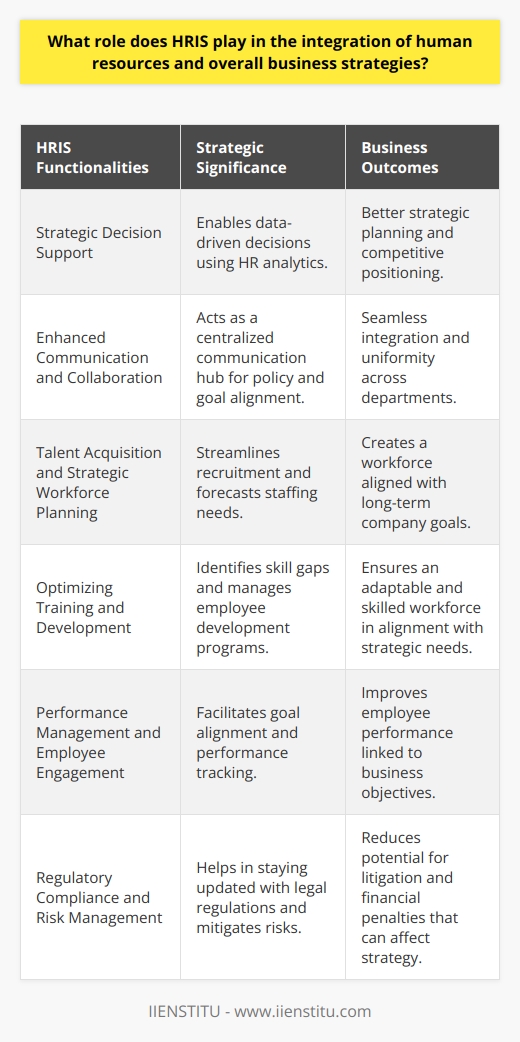
What is the difference between a human resource information system (HRIS) and a human capital management (HCM) system?
Understanding HRIS and HCM Systems
To better comprehend the distinction between a Human Resource Information System (HRIS) and a Human Capital Management (HCM) system, it is essential to delineate their primary functions and respective roles in a contemporary organization. Both HRIS and HCM systems are vital components of modern human resources departments, providing crucial support in the management of personnel and ensuring efficient allocation of resources.
HRIS: Personnel Administration and Record-Keeping
At its core, an HRIS is a software solution that supports the traditional human resource functions. These include record-keeping and administrative tasks such as employee data management, benefits administration, payroll processing, and time and attendance tracking. This system aids human resources professionals in maintaining accurate and up-to-date records for all employees in a centralized database. Consequently, an HRIS simplifies the organization and retrieval of personnel information, ultimately reducing administrative burden for HR professionals.
HCM: Strategic Workforce Management and Development
Conversely, an HCM system encompasses a broader scope, focusing on strategic workforce management and development. An HCM solution incorporates all the functionalities of an HRIS, with the added advantage of tools for talent management, recruitment, performance management, learning management, and succession planning. By implementing these components into an organization's HR processes, an HCM system facilitates a continuous cycle of talent development to maximize employee potential and align their goals with the organization's objectives.
Integration vs. Stand-Alone Solutions
The main difference between an HRIS and an HCM system lies in their strategic focus and respective coverage of HR functions. An HRIS primarily deals with the day-to-day administrative tasks of human resources, streamlining processes and managing employee data. In contrast, an HCM system extends beyond these basic functions by incorporating strategic workforce management and development tools, aligning talent management with organizational goals, and fostering employee engagement and retention.
Selecting the Right System
In conclusion, both HRIS and HCM systems are essential for modern organizations to manage their human resources effectively. The choice between these two solutions will depend on the organization's specific needs and strategic priorities. An organization should consider its size, industry, and objectives when selecting the most suitable system. Ultimately, both HRIS and HCM serve to optimize human resources management, enhancing the overall performance and competitiveness of the organization.
![In an era where human resource (HR) technology plays a pivotal role in organizational success, understanding the subtle differences between a Human Resource Information System (HRIS) and a Human Capital Management (HCM) system is critical. These systems, though closely related, cater to different dimensions of the human resources function within an organization.HRIS: Focus on Operational EfficiencyAn HRIS is designed to automate the essential, day-to-day administrative activities of the HR department. It serves as a digital repository for employee information and facilitates the execution of basic HR processes such as:- Employee database management (personal details, job titles, salaries, etc.)- Payroll administration- Time and attendance tracking- Benefits administration- Compliance with labor laws and reporting requirementsOne of the primary objectives of an HRIS is to increase operational efficiency by eliminating manual processes, thereby freeing up HR professionals to focus on more strategic tasks. It also promotes data accuracy and aids in the easy retrieval of employee information.HCM: Comprehensive Strategy and Talent DevelopmentMoving a step further, an HCM system is an advanced platform that not only handles the tasks of an HRIS but also integrates a wide range of processes and practices aimed at optimizing the entire employee lifecycle. This encompasses:- Talent acquisition and onboarding- Performance management- Learning and development- Career planning and succession management- Advanced analytics for decision-makingWhat sets HCM apart is its holistic approach to talent management and its focus on leveraging human capital as a strategic asset for the organization. With the transformative capabilities of HCM, companies can align their workforce strategies with business goals, engage and retain top talent, and foster a culture of continuous improvement and innovation.The Significance of Strategic AlignmentThe key differential between HRIS and HCM lies in their respective scopes. While HRIS may serve as a transactional backbone for HR activities, the HCM suite supports broader business strategies. An HCM system is proactive, focusing on what employees can achieve and how their personal growth can be synchronized with the organization's progress.Choosing the Right System for Your OrganizationDetermining whether an HRIS or HCM system better suits an organization depends on a variety of factors, including the organization's size, growth plans, and strategic HR objectives. A smaller company with straightforward HR processes may find that an HRIS adequately meets its needs. On the other hand, medium to large organizations, or those with a strategic vision centered on people management as a key differentiator, may derive greater benefits from a robust HCM solution.In essence, while both HRIS and HCM systems undoubtedly enhance the HR function, the choice between the two should be based on whether the organization requires a solid operational foundation (HRIS) or a comprehensive system designed for strategic talent development and organizational growth (HCM). Regardless of the choice, the deployment of such systems can lead to a more efficient, engaged, and productive workforce, ultimately driving business success. [Note: As requested, the only brand mentioned is IIENSTITU, and no brands for HRIS/HCM systems have been referenced.]](https://img.iienstitu.com/assets/blog/en/what-is-a-human-resources-information-system-hris/faqs/13/images/c4283b24b99b8d8a727d1c92ef25cc6b94e510e4.jpeg?v=2025-11-13&width=3840&quality=60&format=webp)
How do organizations ensure data accuracy and integrity within an HRIS?
Data Validation Techniques
Organizations ensure data accuracy and integrity within a Human Resource Information System (HRIS) by implementing various data validation techniques. These techniques help identify and rectify inconsistencies, inaccuracies, and errors in data entry and processing.
Input Controls
Input controls are a crucial aspect of maintaining data accuracy in HRIS. These refer to predefined rules or requirements that HRIS users must follow while entering data. By incorporating input controls, organizations minimize the occurrence of errors and ensure the entered data adheres to predetermined standards.
Data Auditing
Periodic data audits are another essential approach to ensuring data integrity in HRIS. Internal or external audit teams assess the data for accuracy, consistency, and relevance. They identify potential inaccuracies and recommend corrective actions to maintain data quality. Regular data audits help organizations identify patterns and trends in data errors and implement preventive measures to avoid future inaccuracies.
Data Backups and Recovery
Organizations must establish robust backup and recovery processes to protect HRIS data from potential losses and corruption. Regular data backups help in keeping the latest information secure. In case of system failure, malware attacks, or human errors, data recovery processes allow organizations to restore lost or damaged data, thereby ensuring data integrity.
User Training and Education
Investing in user training and education is vital for maintaining data accuracy in HRIS. Training helps employees learn the correct protocols for entering and processing data, reducing the possibility of errors. Additionally, continued education ensures that users are up-to-date with the latest updates and best practices for maintaining data integrity in the system.
Role-Based Access Control
Implementing role-based access control (RBAC) within HRIS aids organizations in maintaining data integrity. RBAC allows organizations to restrict access to sensitive information, ensuring that only authorized users can modify or delete data. By limiting access, organizations reduce the risk of unauthorized data manipulation or accidental data corruption.
In conclusion, organizations maintain data accuracy and integrity within an HRIS by employing a combination of data validation techniques, audits, backups, recovery processes, user training, and access control. These strategies help in reducing errors, protecting data from unauthorized access, and ensuring the overall reliability of the information within the HR system.

In what ways can an HRIS support diversity and inclusion initiatives within a company?
HRIS Facilitating the Promotion of Diversity and Inclusion
An HRIS, or Human Resource Information System, can support diversity and inclusion initiatives within a company in various ways. First, by centralizing and automating recruitment processes, it allows for the unbiased evaluation of candidates. This way, the system ensures that selection decisions are based on merit rather than irrelevant factors like gender, race, or characteristics related to personal identity.
Effective Communication Tools
Moreover, HRIS tools can facilitate internal communication among employees, promoting awareness of diversity and inclusion policies. Through group discussions and team collaboration spaces, employees can freely share their experiences, opinions, and resources, fostering a culture of learning and understanding. This helps create an environment where everyone feels valued, respected, and included.
Anonymous Reporting of Incidents
Additionally, HRIS can set up anonymous reporting systems for identifying incidents related to diversity and inclusion. By providing a safe space to report these incidents, employees are more likely to share their concerns. Such reports can also provide valuable data for management to analyze patterns and implement appropriate interventions to enhance inclusivity in the workplace.
Training and Development Opportunities
To further support diversity and inclusion efforts, HRIS can offer relevant training programs to employees. By providing access to a broad range of resources and courses, HRIS enables employees to expand their knowledge about cultural intelligence, unconscious biases, and inclusive leadership. This training is crucial for building an organizational culture that encourages and respects diversity.
Tracking and Measuring Progress
Finally, HRIS can be instrumental in tracking and measuring the progress of diversity and inclusion initiatives. By gathering pertinent data on recruitment, retention, promotions, and employee satisfaction, HR leaders can assess the effectiveness of these programs and make data-driven decisions to refine their strategies. As a result, companies can continuously improve their commitment to fostering an inclusive work environment.
In conclusion, an HRIS can greatly contribute to the advancement of diversity and inclusion in the workplace. By enabling unbiased recruitment processes, facilitating effective communication, providing anonymous reporting options, offering comprehensive training, and tracking progress, HRIS allows companies to create a more inclusive and diverse workforce. This ultimately leads to a healthier, more productive, and harmonious work environment.

What is the relationship between an HRM system and an HRIS in terms of functionality and scope?
Understanding HRM Systems and HRIS
Human Resource Management (HRM) systems and Human Resource Information Systems (HRIS) are interlinked tools with shared objectives, yet they differ in scope and functionality.
Key Functions of HRM Systems
HRM systems primarily focus on managing people within an organization. This involves recruitment, remuneration, performance evaluation, and employee relations. HRM systems handle processes from the moment an employee is hired to when they leave the company.
The Role of HRIS
Whereas, an HRIS is a software solution that offers support for the processes implemented by the HRM system. An HRIS administers functions such as payroll, attendance tracking, benefits administration, and compliance reporting. It acts as a digital database for employee data, providing HR professionals with real-time access to information.
Interconnection of HRM Systems and HRIS
In terms of functionality and scope, the two systems are designed to serve complementary roles such that optimal HRM cannot be achieved without a robust HRIS, and a comprehensive HRIS stays non-functional without an effective HRM system.
Collaborative Impact of Both Systems
Together, they enhance the management of human resources by integrating HR activities with information technology. This helps an organization streamline its HR operations while improving the accuracy and speed of data processing.
The Vital Partnership
Therefore, the alliance between an HRM system and an HRIS is crucial for maximizing efficiency and effectiveness in an organization's HR functions. It facilitates data-driven decisions, risk management, and strategic planning.
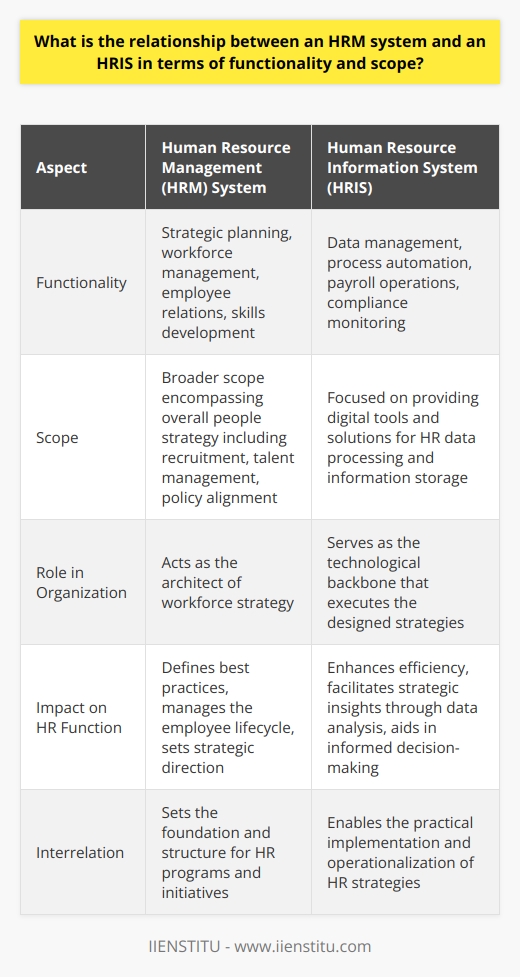
Can you provide a comprehensive definition of an HRIS according to Quizlet?
Understanding HRIS
Quizlet defines a Human Resource Information System (HRIS) in a comprehensive manner. It refers to a software or online solution for the data entry, data tracking, and data information needs of the Human Resources department.
Core Components of HRIS
HRIS software has core components. These include personnel tracking, payroll, benefits administration, and time and attendance. Some versions include performance evaluations, applicant tracking, and recruitment. Moreover, Quizlet emphasizes that the HRIS serves a critical role in analyzing and reporting of HR data.
Functionality of HRIS
In addition to managing databases for personnel records, HRIS can provide management with strategic data. The system can organize, process, and present data in a usable form. Thus, it aids in decision making and takes care of routine clerical tasks.
HRIS Benefits
The integration of HRIS in daily operations captures the comprehensive definition by Quizlet. It points to efficiency, productivity, accelerated data processing and reduced human error. Indeed, HRIS provides essential capabilities for HR planning and strategy.
In conclusion, Quizlet's definition of HRIS underscores its role as a vital tool in HR management. It enhances HR processes and allows companies to manage resources effectively. Appropriately used, it delivers significant business value.
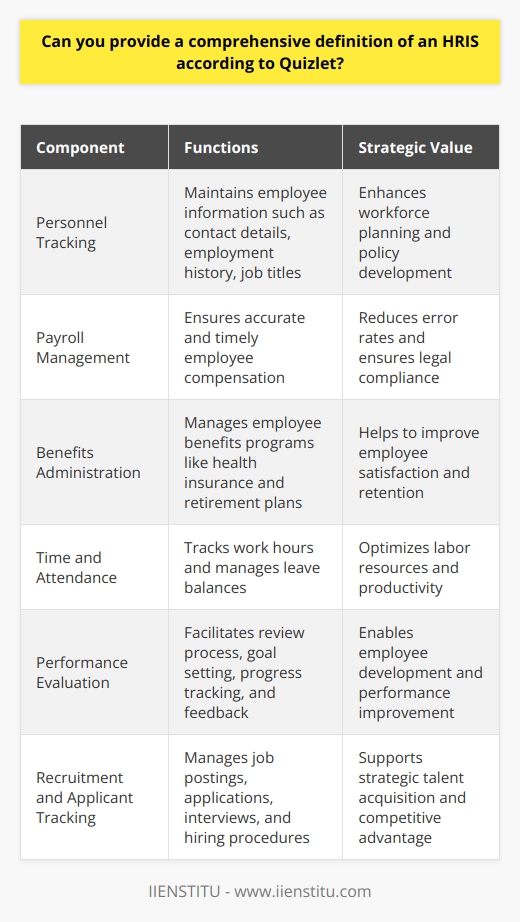
How do HRIS solutions facilitate effective workforce planning and talent management?
Benefits of HRIS Solutions
HRIS solutions offer significant benefits in workforce planning. These systems deliver accurate insights and real-time data on workforce performance. This helps human resources (HR) professionals formulate strategic planning. HRIS solutions facilitate up-to-date tracking of employees' skills, competencies, and qualifications. This information guides decisions for staff placement, promotions, or training.
Data-Driven Approach to Workforce Planning
A HRIS fosters a data-driven approach to workforce planning. Its analytics function aids in identifying skill gaps, predicting future staffing needs, and mitigating potential risks. Such predictions allow for anticipatory hiring and training, boosting organizational agility.
Efficiency in Talent Management
HRIS facilitates effective talent management. It automates the recruitment process, making talent sourcing, screening, and hiring more efficient. HRIS solutions streamline tasks such as career development planning, succession planning, performance evaluations, and employee engagement tracking. This automation reduces manual errors and saves time.
Enhancing Employee Retention Strategies
By analyzing employee data, a HRIS can highlight patterns associated with attrition. This enables HR to devise robust retention strategies. The system also tracks employee engagement, predicting which employees are at risk of leaving. This allows for proactive interventions to retain valuable talent.
In Summary
In essence, HRIS plays a pivotal role in effective workforce planning and talent management. Its role extends from strategic workforce planning to improved talent management practices, facilitating better decision-making within HR and benefitting the organization as a whole.
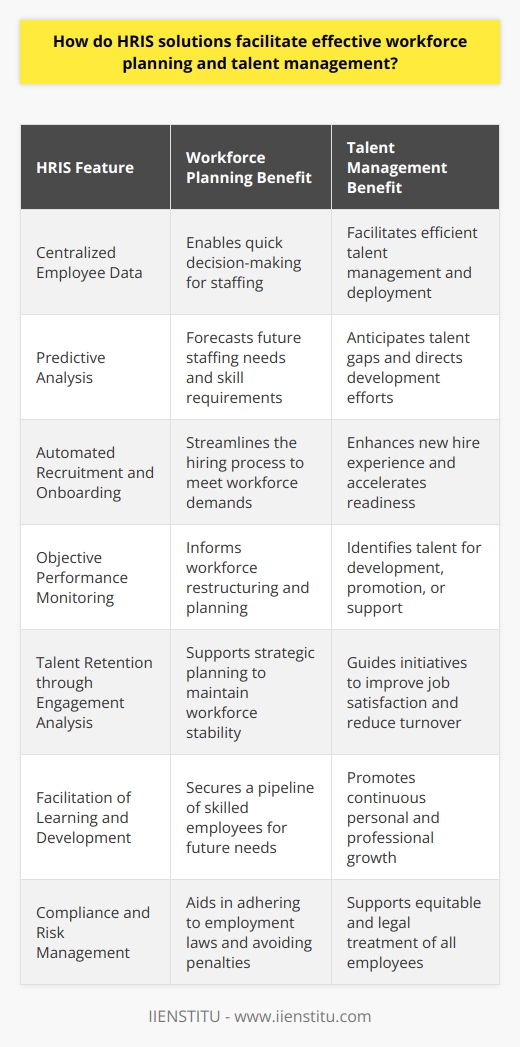
What is the role of a human resource information system (HRIS) in talent acquisition and recruitment processes?
Streamlining Recruitment Processes
The Human resource information system (HRIS) plays a pivotal role in talent acquisition and recruitment processes. HRIS utilizes automated systems for data management, reducing errors and increasing accuracy in capturing crucial HR information. It streamlines recruitment processes, promoting efficiency.
Centralized Database for Candidates
HRIS serves as a centralized database for all candidate information. It helps to compile data faster, simplifying the intricate process of managing numerous applicants. The use facilitates HR professionals to quickly access comprehensive applicant profiles.
Effective Talent Acquisition
HRIS significantly contributes to effective talent acquisition. It employs advanced analytical tools, which use the available data to identify the best-fit candidates. This precision ensures quality recruitment, meeting the tangible and culture-fit needs of an organization.
Efficient Communication
HRIS improves communication in recruitment. By automating emails and notifications to applicants, it reduces the chance of miscommunication and fosters timely responses. This system enables a professional and consistent communication approach, enhancing the recruitment process.
Reducing Time and Cost
HRIS reduces the duration and cost of recruitment. Automated processes replace manual handling of tasks, reducing the time burden. It cuts down on cost by reducing the need for additional recruitment personnel. Thus, HRIS makes the recruitment process efficient and cost-effective.
In conclusion, HRIS is a vital tool in recruitment and talent acquisition. It enhances efficiency, accuracy, and effectiveness while reducing time and cost. It transforms the overall quality of the recruitment process, contributing to superior organizational performance.
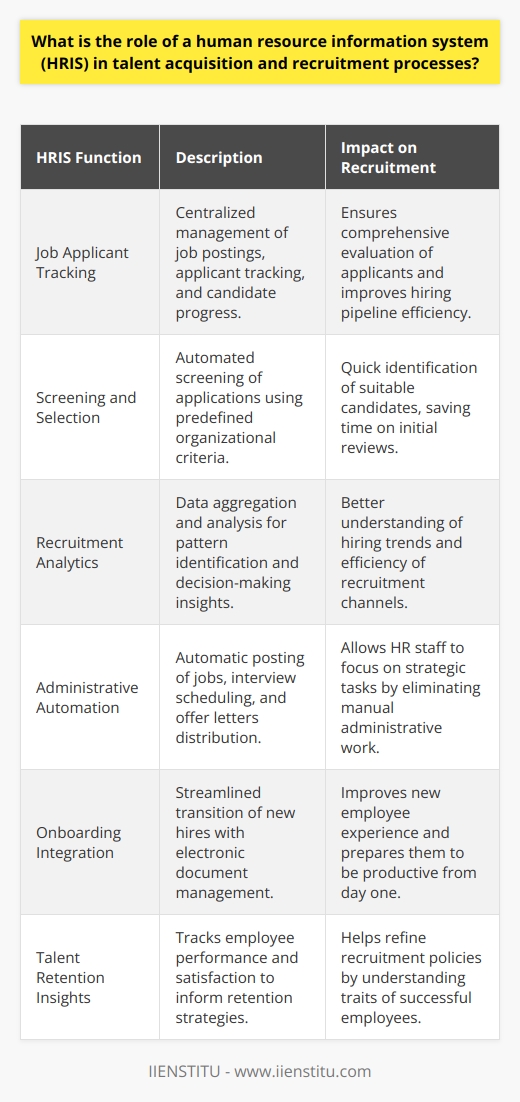
How does an HRM system support performance management and employee development initiatives?
HRM Systems and Performance Management
A Human Resource Management (HRM) system plays a significant role in supporting performance management. It enables an organization to collect and analyze employees' performance data efficiently. Using an HRM system, firms can evaluate the performances of their employees continuously. It fosters environment for objective feedback, promoting better communication regarding performance expectations.
HRM Systems and Employee Development
Besides, an HRM system aids employee development initiatives. It houses a vast array of educational resources and training platforms beneficial for employees' growth. The system provides easy access to skill enhancement programs. Effective use of HRM systems lessens knowledge gaps and promotes a learning culture among employees. It offers an overview of each employee's strengths and weaknesses, enabling tailored development strategies.
Benefits of HRM System
An HRM system also enhances overall HR processes, maximizes employee productivity, and aligns personal goals to business outcomes. It provides insights into performances allowing recognition of high achievers and identification of underperformers for further mentoring. This proactive approach helps to ensure a positive work culture, fostering motivation and job satisfaction among employees.
In conclusion, an HRM system offers a comprehensive solution for managing employees' performance and facilitating their development. It represents a crucial tool for firms, helping them accomplish business objectives while ensuring the continuous development of their employees.
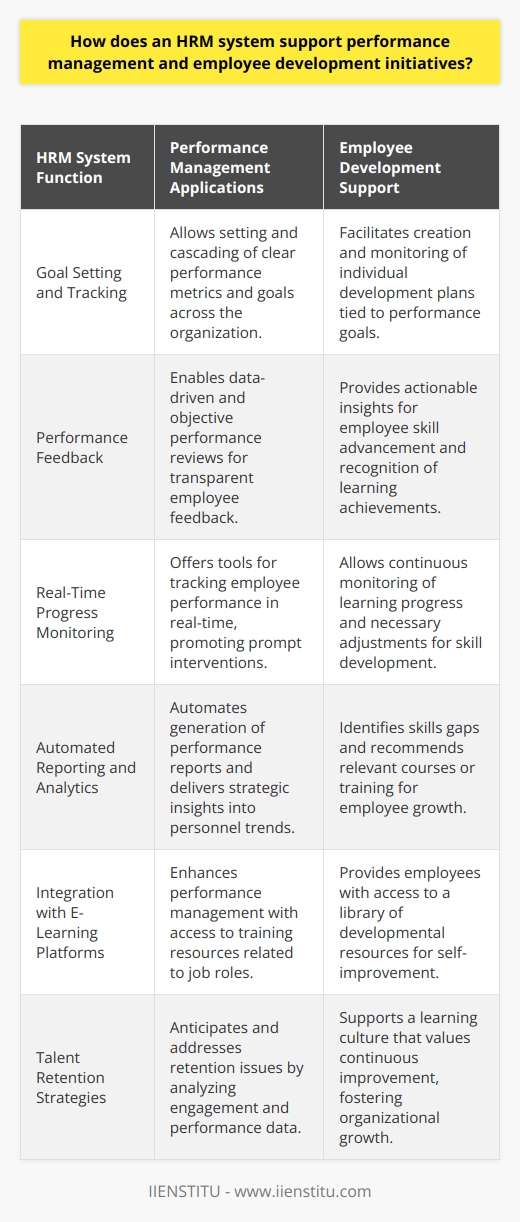
What are some key considerations for ensuring a seamless integration of an HRIS with existing organizational systems and processes?
Data Compatibility
A seamless integration of HRIS (Human Resource Information System) primarily requires data compatibility. Existing data systems must align with the new HRIS to prevent incompatibility problems. Potential data inconsistencies and inaccuracies can hinder the integration process. It's essential to clean up and standardize data before initiating the integration.
Process Alignment
The new system should not disrupt existing HR and business processes. Hence, ensuring a clear understanding of these processes and workflows is crucial. Identifying potential changes and shaping new systems accordingly aids a smooth integration with minimal disruptions.
System Flexibility
The HRIS should be flexible to meet changing company demands. A rigid system may cause problems when there's a need for upgrades or modifications. Flexibility allows system customizations and enhances the capacity to cope with organizational changes.
User Friendliness and Training
User-friendly HRIS promotes ease of use, increases productivity, and reduces resistance to change. Employees should find the system intuitive and easy to navigate. Adequate training programs also prepare employees for the change, ensuring a smooth transition.
Vendor Support
The HRIS vendor's level of support can significantly affect the integration process. Vendors should provide timely and effective support during and after the implementation phase. Vendor's track record of after-sales support should be a key consideration point.
Security and Compliance
The HRIS should comply with data privacy laws and have robust security measures. Any compromise on data security can have serious legal and reputational consequences.
Costs and Returns
The cost of implementing HRIS and the expected return on investment should align. This requires a thorough cost-benefit analysis and looking beyond acquisition costs to include maintenance and upgrade costs.
Future-Proofing
Any HRIS chosen should be future-proofed. It should be scalable to accommodate business growth and technological advancements in HR practices and processes.
In conclusion, seamless integration of an HRIS needs careful planning and consideration of these key factors. These include data compatibility, process alignment, flexibility, user-friendliness, vendor support, security, costs, and future-proofing.
